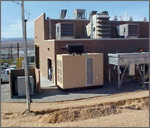
The CHP system at Twentynine Palms MAGTFTC will reduce the base's need to purchase electricity from the local utility by almost two-thirds.
Distributed energy resources (DER) and combined heat and power (CHP) systems can help federal agencies meet increased demand, reduce peak operating costs, and increase system-wide reliability. Use of "distributed" energy systems, in contrast to central generation, can provide benefits to facilities because these smaller, fuel-flexible energy systems are installed close to the point of use. And, as noted in the National Energy Policy Report, distributed energy systems can be brought online faster than new central power plants.
Market studies indicate there are many opportunities to install cost-effective DER and CHP systems in the federal sector, from office buildings to hospitals to remote radar stations. And installing DER and CHP systems may help you meet federal energy goals at your facility.
Through its Distributed Energy Resources and Combined Heat and Power Programs, FEMP provides the support and assistance agencies need to implement successful DER and CHP projects, including technical assistance, outreach and communications materials, and alternative financing support.
Use this site to learn more about these programs, request a free CHP screening, and find out about upcoming DER workshops and training.



















